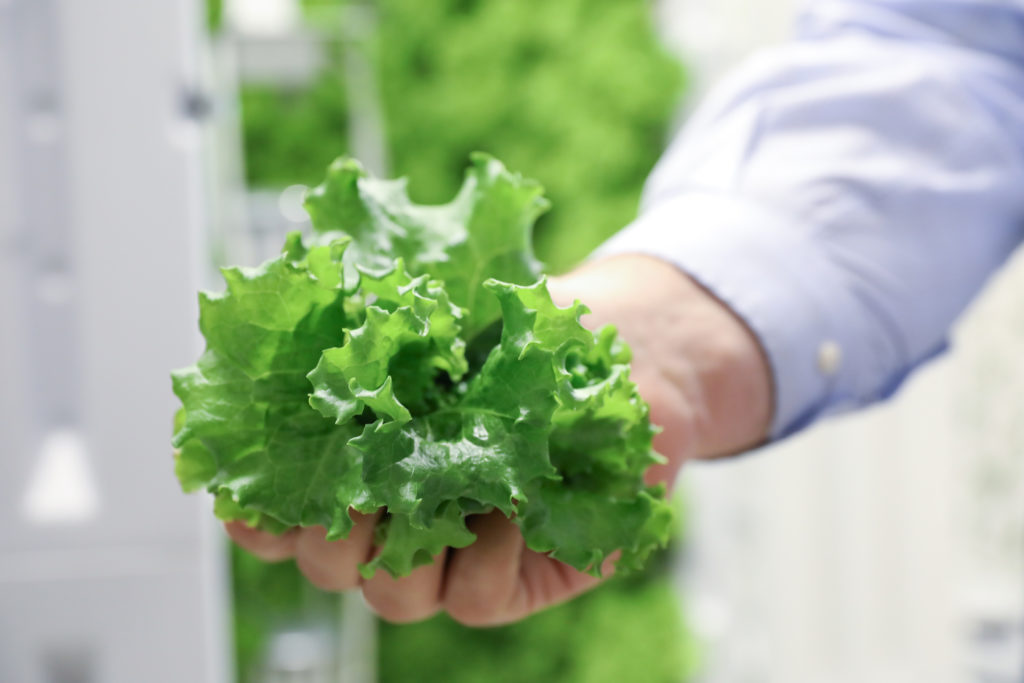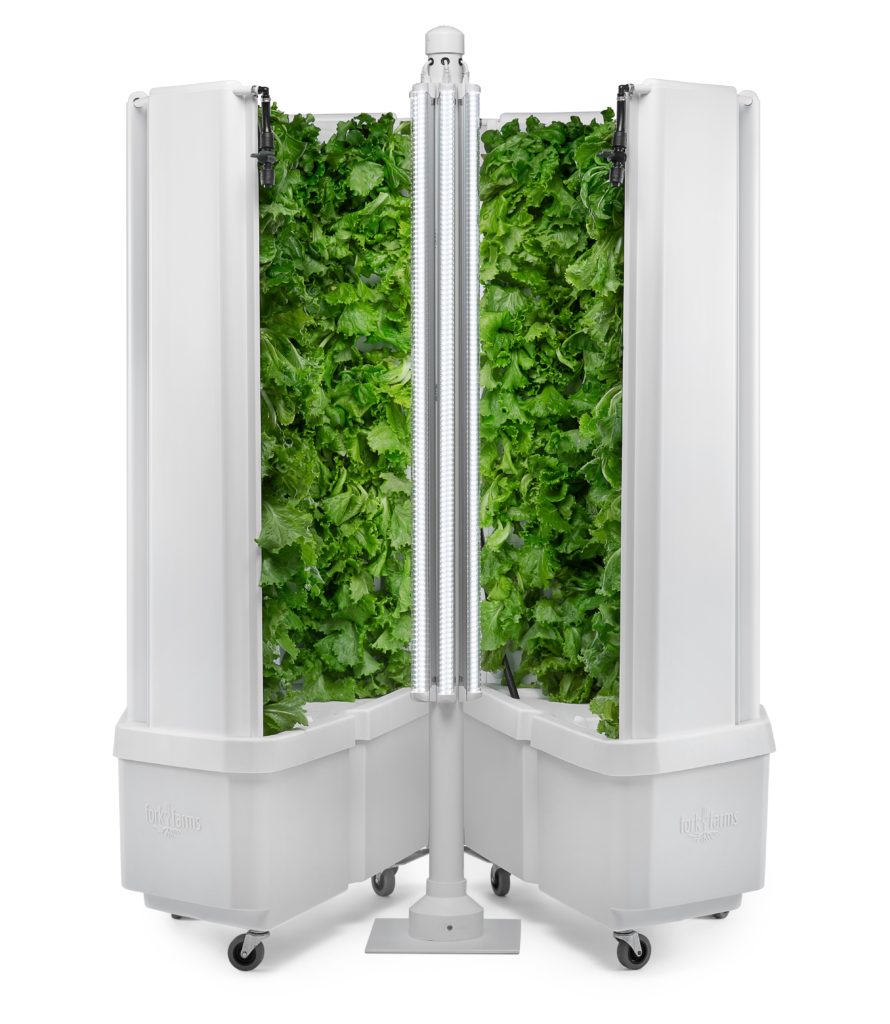Menasha, Wisconsin is located within a 30-minute drive from some of Wisconsin’s most fertile farmland, but access to fresh produce was a problem for the region’s school district. Until the 1990s, the region was home to a booming paper industry and most of the district’s families found employment at the paper mills and related industries. A drop in mill employment and the 2009 recession reshaped the community — today 64% of the student population qualifies for the free and reduced-price meal program and many students are labeled “at risk.”
The district was regularly serving three meals a day to over 2,000 students in elementary school through high school. but administrators wanted to find a better way to impact nutrition for the students.
In January 2018, Brian Adesso, director of business services for the Menasha Joint School District had an innovative idea – what if the district grew all its own fresh lettuce? For several years, Adesso had been researching how to provide the freshest produce possible to students and staff. School gardens and locally grown produce were a start; however, both were subject to weather, seasonality, and forces often beyond the district’s control
Ensuring kids have access to healthy, fresh school food is crucial to developing healthy habits. More than 30 million American children eat school lunch every day during the school year and the eating habits and food values they learn while in K-12 academic settings will follow them for the rest of their lives.
“Kids today don’t understand where food comes from,” Adesso said. “But I knew we could find a solution that would open their minds.”

Adesso researched indoor gardening across the country and concluded an indoor hydroponic farm was the best and most reliable solution. However, the solution had to fit the district in terms of capital outlay, return on investment, space requirements, and overall efficiency. He was surprised to find the solution in his backyard.
Fork Farms is an agriculture technology company that allows people and communities to participate in the fresh, local food movement — and its main office was a 20-minute drive from the district in Appleton, Wisconsin. The company was founded by Alex Tyink, a social entrepreneur with a mission to unleash the power of fresh food for healthier, happy people and students.
Tyink is an Appleton native with an unusual path to urban agriculture. He studied and trained as an opera singer, then moved to New York to start his career. While living in Brooklyn, he got hooked on rooftop gardening, and started tinkering with building indoor growing systems in the bathroom of his apartment.
“It blew me away that I could grow and harvest my own food in the middle of New York City,” Tyink said. “The produce tasted so much better than what was locally available, and I knew this was something that had to be shared with other people.”
Tyink decided to take urban agriculture out of his bathroom and back home to Appleton where there was land, potential, and a support system. He eventually graduated from an entrepreneur training program and took his mission to the regional offices of Feeding America.

While he was working with Feeding America Eastern Wisconsin, he was refining his prototype. After 5 years and 30 prototypes, he had created the Flex Farm system for indoor hydroponic gardening. Today, the portable system can hold 288 plants, only requires a standard electrical outlet and less than 10 square feet of space to produce over 20 pounds of produce every 28 days. Flex Farms contain all the nutrients, growing medium, lights and other supplies necessary to start growing food.
“Good nutrition and achievement go hand in hand,” Tyink said. “Children are our most important resource. yet we feed them with outdated produce that has almost no nutritional value by the time it reaches our tables.”
We can grow food for less than $1 per pound. And we can do it with an easy to use, low maintenance system for schools.
Alex Tyink
At the Menasha Joint School District, food service had purchased greens from a national food supplier — greens that were grown in Arizona, trucked to a regional distribution center in the Midwest, and then trucked again to the school. By the time the bagged greens arrived, they had a shelf life of only a few days. The prospect of fresh greens year-round was mouthwatering.
“These systems are used for 4-star restaurants and I thought it was a good idea to bring the concept into a low socioeconomic population,” Adesso said. “These kids could have the same experience as a diner in a fine restaurant has.”
“We can grow food for less than $1 per pound,” Tyink said. “And we can do it with an easy to use, low maintenance system for schools.”
Initially Adesso wanted to go big and put several Flex Farms into use for the district, but budget constraints caused him to start with four Flex Farm systems. He selected four systems so the crop cycle would deliver a fresh harvest on an ongoing basis.
Did the students come rushing for fresh salads?
“Honestly, we first took a lettuce plant roots and all, and put it in a jar to show the kids what we were growing and what they were eating,” Adesso said. “After they got over the gross-out factor due to something being “grown” and figured out how good it tasted, they really enjoyed it.” Today, the school does not mix the home-grown, crunchy, fresh greens with greens supplied by food service, because that’s what students prefer.
After the initial experiment, Adesso moved the indoor system from the high school to the basement of an elementary school and now has 12 daisy-chained Flex Farms in operation. A dozen of them produce fresh greens for the district and maintenance is easy because they share one water/nutrient system.
Food isn’t the only byproduct — a 13th Flex Farm is dedicated to experimentation with other leafy greens. Classes in the elementary school conducted a living STEM experiment growing tomato plants in the systems and other crops. To support ongoing learning, Fork Farms offers a robust curriculum package with lesson plans on planting, growing, and raising an indoor garden.
“The kids see how plants grow, how they need water and sunlight,” Adesso said. “I’m hopeful that we can do more experimentation like this and I hope this translates into more than just food service.”
As for operational costs, Adesso says the annual costs are equivalent to what the school district purchased the lettuce for from a food distributor. His biggest investment was the upfront cost of the Flex Farm systems themselves. However, the ROI on the systems and low maintenance costs made it an easy decision.
The impact of the Menasha Joint School District model is no longer just local. The project has caught the attention of school districts across the country and provides an easy blueprint for districts on a micro and macro scale. And for school children in Wisconsin, fresh produce is no longer only a summer crop.

